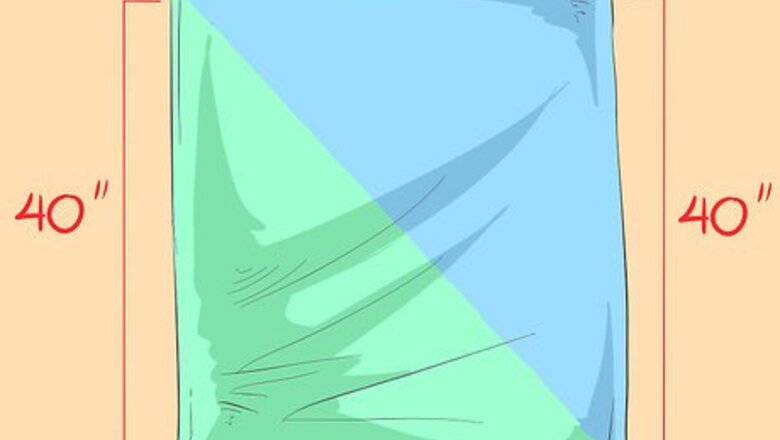
views
Using a Piece of Cloth as a Sling
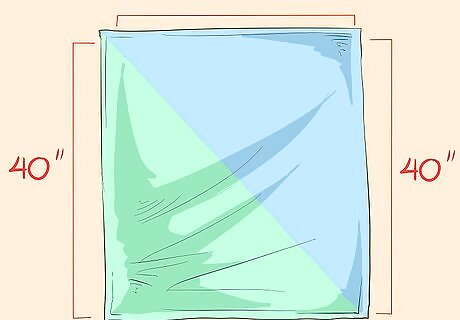
Find a suitably-sized square of cloth. This method uses a square of fabric to replicate the functionality of a real sling. Depending on your height and size, the precise size of the cloth you'll need can vary. For most people, a square of fabric that's roughly 40 in (1.0 m) on each side will work well. Ideally, you'll want a fairly inelastic piece of fabric—stretchy fabric allows your arm to bend and move, which can aggravate your injury. One easy way to get a 40 in (1.0 m) square piece of fabric is to cut an old pillowcase or bed sheet that you don't mind ruining to size with a pair of sharp scissors or a fabric knife. In a pinch, you can even use your bare hands to tear these things to the right size. When it comes to your sling fabric, err on the side of using a fabric square that's too big, rather than too small. A sling that's too big can be tightened by adjusting the knot behind your head while wearing the sling, but there's no real way to make a sling looser than the length of its fabric allows.
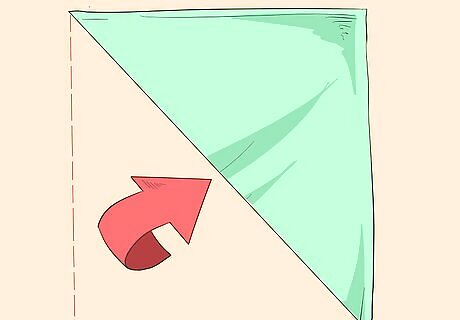
Fold the cloth in half diagonally to make a triangle. Next, you'll want to fold the fabric of the cloth across itself diagonally to form a triangle. When worn as a sling, the "fat" middle portion of the triangle will support your arm and the thin corners of the triangle will form a comfortable neckband behind your head. If, for some reason, you find that the sling isn't comfortable while folded, you can alternatively cut the square diagonally to create the same shape.

Clean and dress any wounds before wearing the sling. When wearing the sling, your arm will be held in contact with cloth which, if you're making your own sling from home materials, has probably not been disinfected. Thus, if your injured arm has any open wounds, it's extra-important to ensure that all of your wounds are cleaned, dried, and carefully bandaged before you introduce them to the sling's material. Below is a rough guide for cleaning minor wounds—see How to Care for Minor Abrasions and Scratches for more information. If you have a serious injury or see a bone at the site of the injury, don't attempt to make yourself a sling—go to a hospital immediately. First, wash any open wounds BUT do not use extremely cold or extremely hot water. And use slow flowing water, not a harsh stream. If you do anything mentioned not to, you will surely hurt your arm even more. Remove dirt or any other debris from the wound with a clean pair of tweezers if it is not rinsed out by water. Apply a bandage over the wound. Use a bandage that covers the wound completely with no adhesive portion touching the wound itself. If needed, you may want to place clean gauze between the bandage material and the wound. You also may need to have a splint, in which case you should apply it first before the sling. Do not directly touch the wound unless you have medical experience.
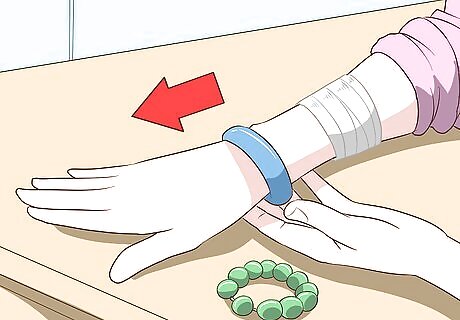
Remove any jewelry from the injured arm. Next, you'll want to take off any rings, bracelets, and/or armbands that you are wearing on the injured arm. If the injured arm swells as it heals, jewelry (particularly tight-fitting pieces) can constrict the flow of blood to the arm, causing pain and irritation and even becoming stuck.
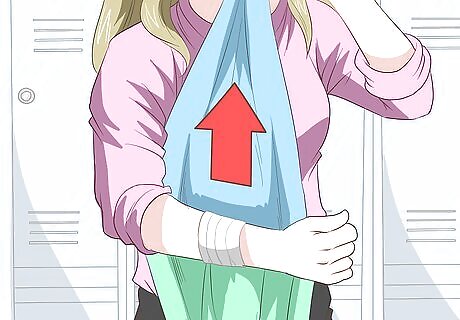
Slip one end of the cloth under your arm and the other over your shoulder. Position your injured arm at a 90-degree angle across your chest (horizontal to the floor). Use your other arm to slip the folded, triangular piece of fabric over the shoulder of your uninjured arm. Let the rest of the fabric hang so that it lies behind the injured arm with the "point" of the umbrella pointing roughly towards the hip that is on the same side of the body as the injured arm.
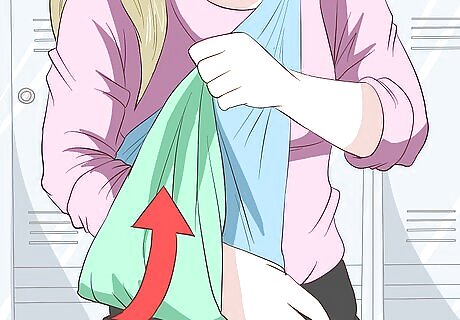
Bring the other end of the sling over your other shoulder. Use your uninjured arm to grab the corner of the triangle that is pointing towards the floor and bring it up across your body, over the opposite shoulder as the other end of the fabric, and behind your neck. Do this gently, as the fabric should now be touching the injured arm and can jerk on the arm if pulled roughly. The length of the sling material should be such that the injured arm can hang comfortably at a roughly 90 degree angle. Your fingers should extend just far enough beyond the "cuff" of the sling that it's possible to use them for simple tasks like writing while the hand is still supported by the sling. If this is not the case, adjust the fit of the sling as needed.
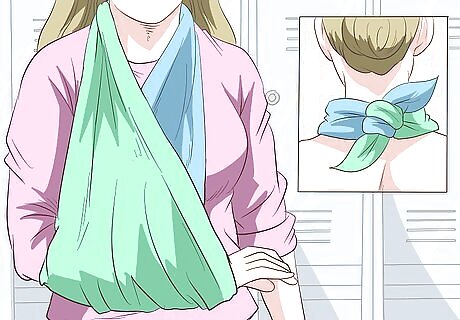
Tie the ends of the sling behind your neck. When you've found a comfortable length for your sling, tie a simple knot in the two ends of the sling material to secure the sling behind your neck. If you need to adjust the height at which your sling hangs, loosen this knot and tie a new one either further "up" or "down" the length of the fabric. Congratulations! Your new sling is ready to wear. If this knot uncomfortably digs into your neck, slip a small pad or towel under it. Be sure to avoid the hair at the nape of your neck when tying your knot. If you accidentally tie some of your hair into the knot, it can be painfully yanked when you move your arm or walk.

If desired, close the edge of the sling with a safety pin. If you have a safety pin handy, pin the two edges of the sling material near your elbow together. This creates a "backstop" for your elbow to rest against. Without this backstop, it's possible for your arm to slip out the back of the sling as you move or for the sling material to bunch up near your wrist.
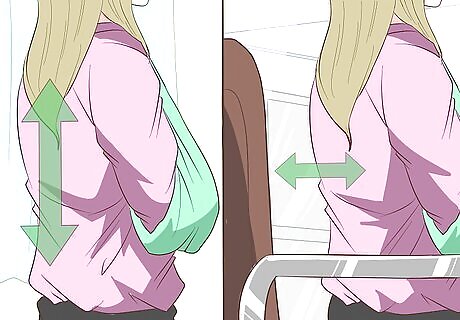
Maintain good posture while you wear your sling. A sling transfers the weight of your injured arm onto your upper back and neck. This added burden can cause back and neck strain—even if you don't experience serious strain, over time, you'll probably notice that your sling causes the area between your shoulder blades to become fatigued. Lessen this effect by maintaining proper, erect posture. See below for brief posture instructions: When you stand while wearing your sling, keep your back straight and your shoulders in a pulled-back but relaxed position. Keep your chin up and avoid slouching. When you sit while wearing your sling, keep your back against the chair's backrest, if there is one. Keep your back straight and upright. Keep your head and chin up so that your neck stays straight. Keep your feet planted on the ground. Don't sink into a slump or slouch. If you can comfortably support your arm on the chair's armrest, you may do so. If at any point while wearing a sling, you experience severe back or neck pain, see a doctor. Avoid wearing a sling if you have a known neck or back ailment.
Improvising a Sling from Clothing
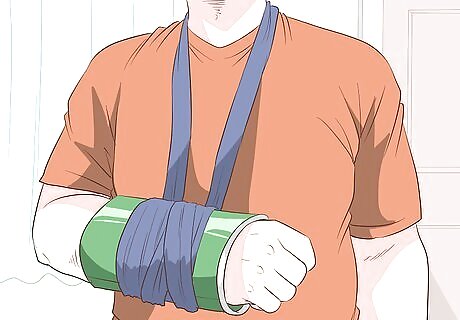
Improvised slings are not as good as professionally-designed slings. Modern slings are much more comfortable, ergonomic, and protective than what most individuals can craft. However, arm injuries can happen and you may have to improvise. If you are injured in the wilderness while on a camping trip, if may be impossible to obtain cloth to make the sling above. It is certainly better than no sling at all.
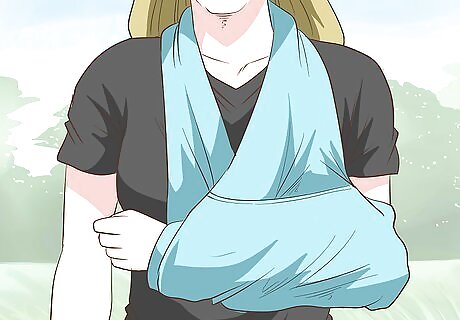
Use a long-sleeved garment as a sling. Use a sweater, sweatshirt, button-up shirt, or other long-sleeved garment. Tie the garment's sleeves behind your head and carefully insert your injured arm through the loop formed. Allow the clothing material to support the weight of your arm somewhere along the forearm or wrist - wherever is comfortable. Try to adjust the length of the garment's sleeves that your knot allows to hang so that your arm can hang at a roughly 90-degree angle (horizontal to the ground). If you have safety pins handy, you may want to try "closing" the fabric of the long-sleeved garment around your elbow as a makeshift backstop for your sling as described in the method above.

Use a belt as a sling. One piece of clothing seemingly tailor-made for improvised slings is the belt, due it having the built-in ability to form a loop with an adjustable size. Secure the belt buckle behind your neck and slip your arm through the loop formed by the rest of the belt. Allow your arm's weight to be supported by the belt along the forearm or wrist. Tie or fasten the belt behind your neck so that your arm is supported at a 90-degree angle. The belt's buckle can be uncomfortable against the back of the neck, so may want to shift the belt so that the buckle is in the length of belt stretching between your arm and neck. You can also put padding between the belt and your neck for greater comfort.
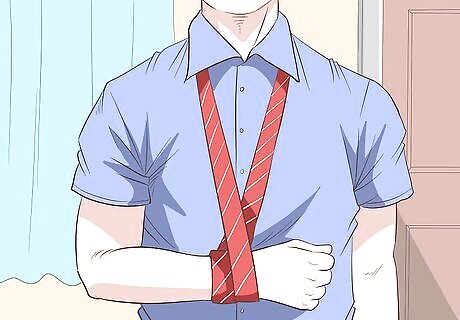
Use a tie as a sling. If you're injured in an office setting or while wearing formal wear, a necktie can suffice as a makeshift sling until a real one is available. As with the methods above, simply tie the necktie behind in a simple knot your neck and pass your arm through the loop formed. Adjust the positioning and length of your makeshift sling so that your arm hangs at a 90-degree angle.
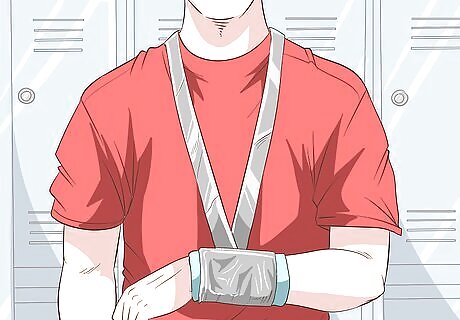
Duct tape. Duct tape can be used very effectively to help immobilize the arm. It has strength, flexibility, and a fabric-like quality which lends itself quite well to this situation. A loop of duct tape can substitute for a belt or tie, supporting the wrist, arm, and elbow. Duct taping the injured arm to the torso can help reduce movement. Be sure to avoid getting duct tape residue on the skin. Duct tape should be faced so that it does not adhere to the skin.
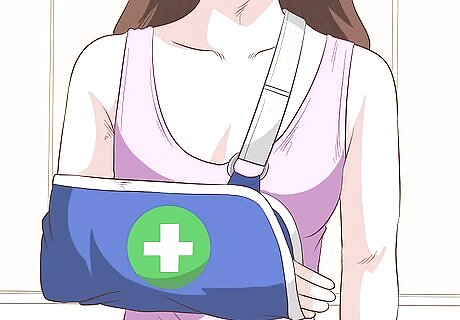
Seek medical attention (and/or a real sling) immediately. The types of situations in which you'll need to make a sling from your clothing are usually situations in which actual medical care is for some reason unattainable. If your injury is at all serious or persistent, seek the help and advice of a trained medical professional as soon as you can. Improvised slings are usually better than no sling at all, but they are no substitute for a real sling (to say nothing of the other treatments for an injured arm that a hospital can provide). It's better to be safe than sorry—don't risk worsening your arm injury by neglecting to show it to a doctor.
Handling a Severe Case
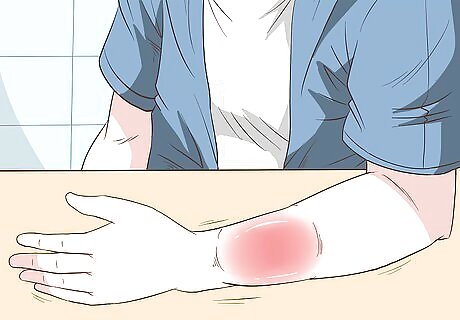
Seek medical attention for broken bones or dislocations. A homemade sling may be a good choice for minor arm injuries, but it's not enough to ensure proper healing in the case of serious fractures or dislocations. Allow a doctor to examine the injury, take x-rays, and discuss a treatment plan with you. A doctor's final treatment plan may involve the use of a sling – but your injury might also require a cast or surgery. If you use a homemade sling to set a broken bone or a dislocated limb, your arm might heal poorly. You may experience lasting discomfort, and you may need further medical attention. Common symptoms of broken arms include: Intense pain Tenderness Swelling Loss of motion or decreased sensation Possible open wound with bone sticking out Difference in appearance relative to the uninjured arm Common symptoms of dislocated arms (most commonly in the form of a dislocated shoulder) include: Pain in the arm, shoulder, and/or collarbone Deformation (a bump on or near the shoulder) Swelling Bruising
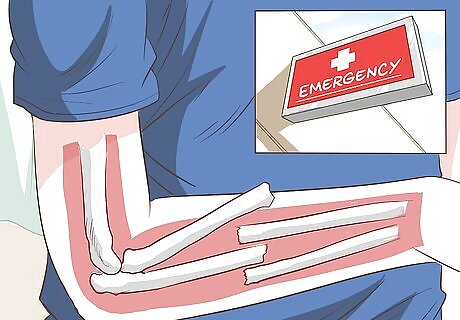
Head straight to the emergency room if you can see a bone in the wound. When a broken bone sticks through the skin—or a wound forms in which bone is visible following a fracture—this is called an "open fracture" or "compound fracture." These fractures are exceptionally painful, dangerous, and difficult to treat. Be aware that the types of injuries that cause compound fractures can also cause other serious trauma. It is essential that you get yourself prompt, effective medical treatment. Do not try to realign compound fractures without the help of a qualified medical professional. The only exceptions to this rule are rare, special cases: when you will not be able to secure immediate medical treatment, and setting a compound fracture by hand is preferable to the alternative of doing nothing at all.
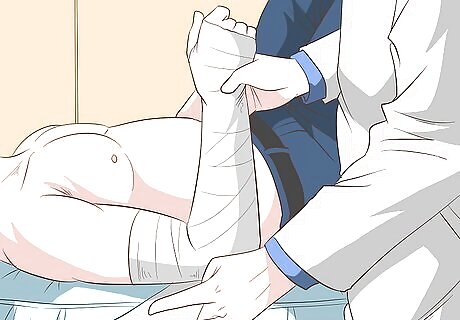
Only try to reset a bone if you are at risk of losing a limb. You should only ever attempt to realign broken bones when signs of poor circulation appear. Again: if possible, wait for a doctor to reset your broken bones. The exception is when it appears that a fracture is preventing blood from circulating through the limb. Your limb may not be receiving any blood if the area of the limb past the fracture looks pale or blue, has no pulse, loses sensation, or grows cold. In these cases, the potential loss of the limb outweighs the dangers of having an amateur re-set the bone – or of doing the job yourself. If this is the case, visit How to Realign a Fractured Bone for more information.

















Comments
0 comment